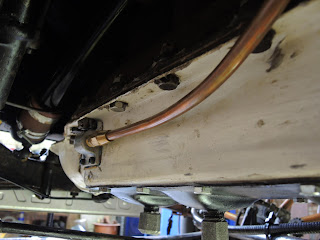Die High Volume Schmierung ist vielleicht der sinnvollste Umbau am Model T. Der Sinn dieser Zusatzausstattung ist mehr Öl an die Lager vorn im Motor zu transportieren. Dies ist besonders dann notwendig, wenn man steile Berge hochfährt.
Die Ölversorgung des Motors funktioniert nicht durch eine Pumpe, sondern lediglich durch von der Schwungscheibe hochgeschleudertes und verteiltes Öl. Das funktioniert deshalb, weil die Magnete des Magnetos an der Schwungscheibe angeschraubt sind. Diese funktionieren wie ein Schaufelrad im Ölbad. Allerdings bekommen die vorderen Motorlager naturgemäß weniger Öl als die hinteren, dem Schwungrad näheren Lager. Dieses Ölsystem wird noch unterstützt durch die Pleuel, welche auch Öl aus den Mulden der Revisionsklappe hochschleudern. Diese Mulden sieht man gut in dem ersten Bild. Die zwei Muttern im Bild sind übrigens nicht original. Das ist eine Idee von Werner. In diesen Muttern sammelt sich Ölschlamm, Partikel und auch Wasser. Diese kann man beim Ölwechsel abschrauben und den Inhalt entfernen. Damit wird der Ölwechsel noch einfacher und besser.
Ford hatte sich natürlich auch überlegt, wie die Ölversorgung der vorderen Lager zu verbessern ist und hat im Motor einen kleinen Trichter nahe der Schwungscheibe eingebaut, der aufgewirbeltes Öl auffängt und über eine Leitung noch vorn führt. Allerdings hat diese Leitung nur ein Gefälle von 15% (8,5°). Das bedeutet, dass diese Ölversorgung stoppt, wenn man entsprechend steile Berge hochfährt. Das ist nicht gut für den Motor.
Hier setzt die Idee der High Volume Schmierung an. Eine externe Ölleitung mit größerem Durchmesser und größeren Steigung fängt mit einem Trichter Öl an der Schwungscheibe und führt es vorn zur Ölwanne. Die originale Ausführung von Texas T Parts kann ungefähr 900g Öl pro Minute nach vorn fördern.
The high volume lubrication is perhaps the most useful modification on the Model T. The purpose of this additional equipment is to transport more oil to the bearings in the front of the engine. This is especially necessary when driving up steep hills.
The oil supply to the engine does not work through a pump, but only through oil thrown up and distributed by the flywheel. This works because the magneto's magnets are bolted to the flywheel. These function like a paddle wheel in an oil bath. However, the front engine bearings naturally get less oil than the rear bearings closer to the flywheel. This oil system is further aided by the connecting rods, which also kick up oil from the troughs in the inspection hatch. You can see these wells in the first picture. The two nuts in the picture are not original. This is an idea of Werner. Oil sludge, particles and also water collect in these nuts. You can unscrew them when changing the oil and remove the contents. This makes the oil change even easier and better.
Of course, Ford had also thought about how to improve the oil supply to the front bearings and installed a small funnel in the engine near the flywheel, which collects swirled up oil and leads it through a line still in front. However, this line has a gradient of only 12°. This means that this oil supply stops when driving up correspondingly steep hills. This is not good for the engine.
This is where the idea of high volume lubrication comes in. An external oil line with a larger diameter and greater pitch catches oil at the flywheel with a funnel and feeds it to the oil pan at the front. The original Texas T Parts design can deliver about 900g of oil per minute to the front.
Anschluss am Getriebegehäuse:
Connection on the gearbox housing:
Connection to the oil pan:
Bei meinem Motor hat Werner Straube die Version eingebaut, welche nicht von Texas T Parts verkauft wird. Leider fehlt bei diesem Set der Trichter. Der äußere Anschluss, welcher am Getriebegehäuse angeschraubt wird ist dem von Texas T Parts sehr ähnlich, aber ohne den innenliegenden Trichter ist die aufgefangene Menge sehr viel weniger. Es sind nur ca. 200g pro Minute. Das ist aber immer noch mehr, als die originale, innenliegende Ölversorgungsleitung nach vorn führt.
Wir werden später einen selbst gebauten Trichter nachrüsten.
Werner hat einen Bericht auf seiner Homepage www.messing-oldtimer.de.
On my engine, Werner Straube installed the version that is not sold by Texas T Parts. Unfortunately, this set is missing the funnel. The outer connector, which screws onto the gear case, is very similar to the one from Texas T Parts, but without the funnel inside, the amount collected is much less. It is only about 200g per minute. However, that is still more than the original internal oil supply line carries to the front.
We will retrofit a homemade funnel later.
Werner has a report on his homepage www.messing-oldtimer.de.
By the way, there is also a retrofitted connection for an external line at the Magneto's port. However, this is no longer used and is closed.






















